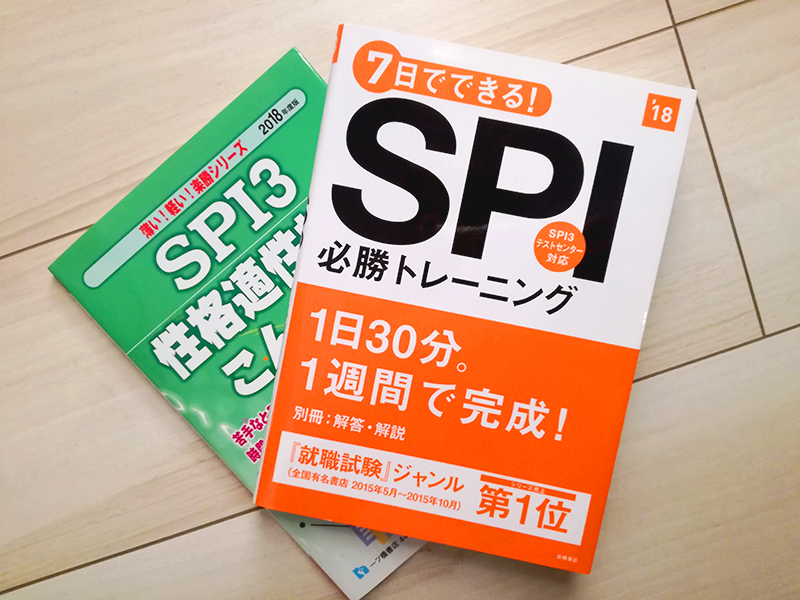SPI Test: Everything You Need to Know

by Madelaine
The SPI test is Japan’s most widely used aptitude test. It tests job applicants for general math and language skills as well as personality. Foreign job seekers tend to struggle with the test because it’s all in Japanese. In this article, we give you an in-depth rundown of the contents as well as some tips on how to prepare.
If you’re looking for free online resources, you can jump to the resources section by clicking here.
コンテンツ
What is the SPI Test?
The SPI test (Synthetic Personality Inventory) is a multiple-choice aptitude test (適性検査). It’s mostly used to test the general abilities of fresh university graduates. English versions of the test are very rare, and many companies will ask foreign applicants to take the Japanese version to ensure “fairness” (a prime example of equality over equity…).
What is the purpose of the SPI Test?
The primary purpose of the SPI is to give the company a general idea about whether or not a candidate meets their requirements. In total, over 11.900 companies include the SPI test in their interviewing process, with over 1.892.000 people taking the test every year. Big companies with lots of applicants use this test to “weed out” candidates before inviting them to a proper interview.
Similar to the JLPT, getting full points is not the primary objective. Unlike the JLPT, a higher overall score doesn’t necessarily equal a more favorable result. The reason for this is that the companies ultimately set their own standards when evaluating your results, based on the areas that are important to the company and the job.
How is the SPI Test structured?
The test is divided into two main parts. In the first part, the skills section tests your general knowledge and problem-solving skills, using Japanese language and math questions. The second part is a classic personality test, to evaluate your character and work ethic.
1.Skills Test: Language
The language section, 言語問題, of the SPI tests your mastery of vocabulary, and your understanding of long texts.
Vocabulary
Can you guess the right answer in the example below?
Select the word pair that is most similar to: 「言語・フランス語」
A 「スポーツ・スケート」
B 「しょうゆ・大豆」
C 「大学・学校」
The word part is about identifying relationships between words.
Study antonyms and synonyms for this part. Being able to realize in which relation words stand to each other is essential.
In both cases the latter word is part of a larger group as defined in the first word. Skating is a sport, just as French is language. Thus the correct answer is「スポーツ : スケート.」
Reading Comprehension
Here, you have to read a couple of short texts each accompanied by 1-3 questions. Typically, you will be asked to choose the answer that best matches the text, or other questions testing your understanding of relations and details within the text. You might also have to fill in the blanks, or put different parts of the sentence in the right order, something you might know from the JLPT.
As this is made to be challenging for Japanese people, it can feel overwhelming if Japanese is not your first language and you might encounter many words that are beyond your daily vocabulary or even completely unknown.
2. Skills Test: Math and Logic
In the math section, 非言語問題 you will encounter mainly math question asking you to solve a certain problem. A basic understanding of percentages, fractions, graphs, probabilities and the likes will help you through it.
3 boys play rock-paper-scissors.
What is the probability that at least 2 of them will show the same hand?
A 1/3
B 1/6
C 2/9
D 7/9
E 11/27
Other possible questions include
- Choosing the right formulas to describe a given area of a graph.
- Calculating a probability as in the example above (the correct answer is D).
- Text questions, requiring you to deduct the necessary information to solve the question.
You shouldn’t have any problem solving these questions, using what you learned during math class in middle school. Only time is an issue, so if it has been a while you might want to revisit some of the basics and look up vocabulary relevant to solving Japanese math questions.
3. Personality Test
This is a classic personality test, 性格適性検査. It assesses your character, by asking a large number of questions about your behavior, ambitions, emotions, and personality.
There are two types of questions. The first type, will ask you to choose between two statements. In the second type, you are asked to state whether you agree with a statement or not.
Intuitive answers are crucial. This part consists of 300 questions with only 30 minutes to answer them. (Depending on your Japanese level, just reading all of them might take up all that time, I know it did for me.)
Questions in this section check for these 5 things:
- 1. Consistency
- Are your answers in the test contradicting each other or your remarks during the interview?
- 2. Alignment with job type
- Do your behaviors and characteristics match the job type you’re applying to? A company might be looking to hire people with strong logical thinking to fill a certain position.
- 3. Alignment with company
- Do your personality and ideals match the company? When applying as designer creativity is a must. For an accountant it would be more important to be well organized or good at time-management.
- 4. Correct answers
- Do you know how to behave in a professional setting? Joking all the time or not being able to control your feelings are aspects that might hurt working relationships.
- 5. Balance
- Do you have a balanced personality? Neither being too shy nor too arrogant flies well in a business environment.
Keep in mind that how these answers will be evaluated depends on the company and position you are applying to. Job requirements and the company philosophy might give you some ideas of what they are looking for in your case.
4. English Test (optional)
Some tests might include an English section. In this case the companies will usually let you know in advance. Since you are reading this article, this section should not prove difficult, so let’s move on.
How to study for the SPI Test?
Knowing the types of questions that appear in the test will help you prepare solution strategies, and review necessary problem-solving skills in advance.
Japanese articles on the SPI specifically point out that this test is not about remembering kanji or mathematical formula. What matters most to get through the test smoothly is having a solid grasp of the basics. Especially kanji and vocabulary can easily break your neck if you spend large amounts of your time just on reading the questions.
Unless JLPT N1 was a piece of cake for you, the reading section is hit or miss, as the vocabulary is too broad. Studying synonyms and antonyms is the most efficient and realistic way to prepare for this section.
You can use a Japanese online thesaurus or try this rather exhausting list of antonyms. I would also recommend to write down the word pairs you encounter in practice questions. They might appear on the test again in some form, and it allows you to build a stock of words you can pick out instantly.
The mathematical questions also follow problem-solving patterns. Things should get a lot easier if you can recognize them at a glance, so look at and solve as many sample questions as possible. In this case, a Japanese SPI training book might be a good investment. It will help you to efficiently prepare for the problem types most likely to appear in the test.
For the personality test, you can use English-language or other personality tests for answering advice and sample questions.
SPI Test Study Resources
As far as I’m aware, there are no English-language only study resources for the SPI test. Japanese material, on the other hand, is really easy to find. If you’re in Japan, check out the nearest bookshop and skim through the available selection. There are complete guides, books focusing on specific parts of the test, books to study key points in a week – pick the one that suits your needs.
Free online study resources
Below, you can find a number of online free (Japanese) online resources for SPI test preparation. These resources may not cover the test contents in the range and depth as a specialized training book, but they’re good to get an idea of what the test is like and what areas you’ll have to work on.
Sample tests
–Smart SPIG (18 minutes; language section 8 questions, math section 7 questions)
–大人塾 (10 minutes; 11 questions)
–キャリタス就活 (language section 10 questions 7 minutes, math section 5 questions 4 minutes
Material for all test sections
–SPI無料学習サイト (Click the tabs at the top to jump go to the respective sections)
Math and logic section
–unistyle (Video guides for the 4 main question types)
–SPI練習問題 (Click on the links in the green box to jump to the question types)
How to take the SPI Test?
The company you are applying to will give you details on the when, where and which of the 4 test types you are going to take.
The 4 ways to take the test and their popularity:
- 1. Online (15% of test takers)
- Take test from any PC, smartphones cannot be used.
- 2. Test Center (65% of test takers)
- Take test from a PC at a test center.
- 3. Paper Test (15% of test takers)
- Take test on paper at the company.
- 4. In-House CBT (1% of test takers)
- Take test from PC at the company.
The test usually takes 65min, with 35min assigned for the skills part and 30min to answer the personality test. Only in the paper test, the skills section takes longer with 70min instead of 35min.
Preparation is Key
Thinking about searching for a job in Japan, but are not quite sure about whether you can make it all by yourself on the first try? Linguage Japanese Language school offers both long- and short-term courses for students of all Japanese levels that combine Japanese education with practical job hunt support. Get advice on how to search to companies, when and how to prepare, and the contents of your entry sheets and CVs! For more info, have a look at our article on the school here or visit the homepage by clicking the button below.
Linguage Japanese Language School



